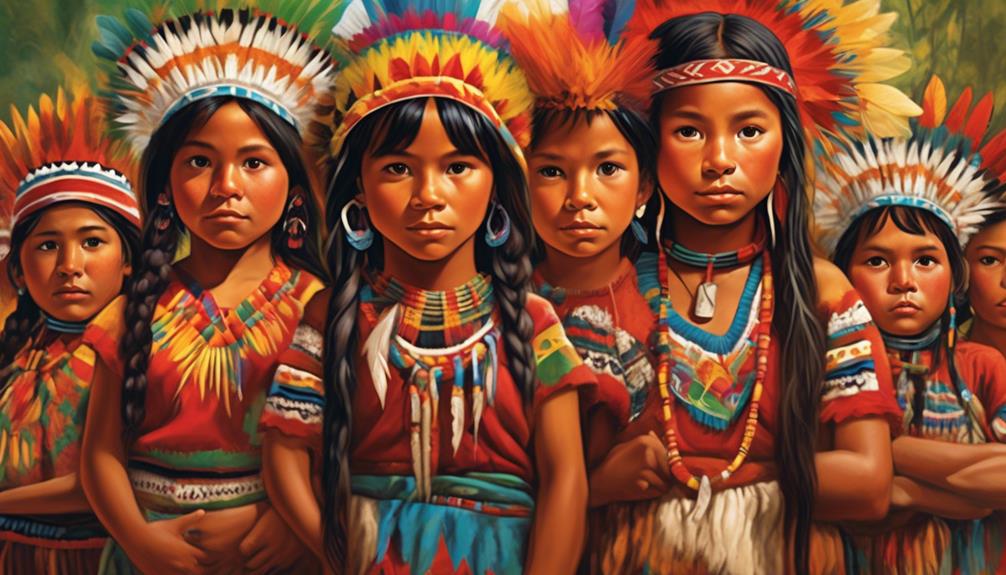It’s no secret that Mexico has a rich and diverse cultural background, but have you ever stopped to consider just how many indigenous languages are spoken in the country? The answer may surprise you.
While we may have some preconceived notions, the reality is far more complex. And as we explore this topic, we'll uncover the fascinating intricacies of language diversity in Mexico, shedding light on a lesser-known aspect of its cultural heritage.
Key Takeaways
- Mexico has over 68 national languages and more than 364 language variants, making it one of the most linguistically diverse countries in the world.
- Many indigenous languages in Mexico are at risk of disappearing within the next few decades due to factors such as globalization and urbanization.
- Efforts towards language revitalization and cultural preservation have gained traction in recent years, with initiatives to integrate indigenous languages into formal education systems.
- The loss of indigenous languages threatens cultural identity, community resilience, and can lead to social marginalization and discrimination.
The Rich Diversity of Indigenous Languages
The rich diversity of indigenous languages in Mexico reflects the complex tapestry of cultural heritage and linguistic traditions across the country. With over 68 national languages and more than 364 language variants, Mexico stands out as one of the most linguistically diverse countries in the world. This linguistic diversity is deeply intertwined with the cultural heritage of the indigenous peoples, representing a wealth of knowledge, history, and identity. Each language encapsulates unique worldviews, social structures, and ways of understanding the environment, enriching the broader tapestry of Mexican culture.
The linguistic diversity in Mexico is a result of centuries of historical and geographical influences, including pre-Columbian civilizations, colonialism, and modern migrations. This intricate web of languages reflects the resilience and adaptability of indigenous communities, who've preserved their linguistic heritage despite significant societal changes. The interconnectedness of these languages offers a window into the intricate relationships between different indigenous groups, contributing to a deeper understanding of Mexico's cultural mosaic.
Furthermore, the preservation of indigenous languages is crucial for maintaining the diversity of human expression and knowledge systems. It's essential to recognize the value of linguistic diversity as a fundamental component of Mexico's cultural richness, fostering respect for indigenous heritage and promoting inclusive national identity.
Endangered Languages in Mexico

Reflecting on the rich diversity of indigenous languages in Mexico, it's imperative to address the pressing issue of endangered languages within the country. Currently, Mexico is home to a significant number of endangered languages, with many at risk of disappearing within the next few decades. This situation is primarily due to factors such as globalization, urbanization, and the dominance of Spanish as the primary language of communication and education.
Efforts towards language revitalization and cultural preservation have gained traction in recent years. Various organizations, both governmental and non-governmental, are working to document and revitalize endangered languages. Additionally, there are initiatives to integrate indigenous languages into formal education systems to ensure their continuity and relevance for future generations.
The preservation of endangered languages is crucial not only for linguistic diversity but also for the safeguarding of unique cultural practices, knowledge systems, and worldviews. It's imperative to recognize the value of linguistic diversity and the importance of preserving endangered languages as an integral part of Mexico's cultural heritage.
Efforts towards language revitalization and cultural preservation are vital in ensuring the survival and flourishing of Mexico's rich linguistic tapestry.
Challenges of Language Preservation
Despite concerted efforts, preserving indigenous languages in Mexico poses significant challenges due to the impact of globalization, urbanization, and the dominance of Spanish. The challenges of language preservation are multifaceted and require comprehensive strategies to address them effectively.
- Lack of Documentation: Many indigenous languages in Mexico lack comprehensive documentation, making it difficult to preserve and pass down linguistic and cultural knowledge to future generations.
- Declining Speaker Numbers: The number of fluent speakers of indigenous languages is declining, leading to an urgent need for language revitalization efforts.
- Educational Barriers: Indigenous communities often lack access to quality education in their native languages, leading to a disconnect between younger and older generations in terms of language proficiency.
- Economic Pressures: Economic pressures and the need to participate in the global economy often lead indigenous communities to prioritize learning Spanish or other dominant languages over their native languages.
- Cultural Erosion: The erosion of traditional lifestyles and cultural practices due to urbanization and globalization further threatens the preservation of indigenous languages and cultural heritage.
Addressing these challenges requires sustained efforts in language documentation, educational initiatives, and cultural heritage preservation to ensure the survival of Mexico's rich linguistic diversity.
Efforts to Revitalize Indigenous Languages

Amidst the challenges of language preservation, ongoing initiatives and programs are actively working to revitalize indigenous languages spoken in Mexico.
Cultural preservation plays a pivotal role in these efforts, as indigenous languages aren't only a means of communication but also a repository of unique cultural knowledge, traditions, and identities.
Educational initiatives are at the forefront, aiming to integrate indigenous languages into formal education systems. Bilingual and intercultural education programs have been implemented to ensure that indigenous languages aren't only preserved but also passed on to younger generations. These programs not only teach the languages themselves but also incorporate indigenous knowledge systems, history, and cultural practices into the curriculum.
Furthermore, community-based initiatives are fostering language use in everyday life, encouraging intergenerational communication and creating spaces for indigenous languages to thrive.
It's essential to recognize the significance of these revitalization efforts in maintaining the rich linguistic and cultural diversity of Mexico. By supporting these initiatives, we contribute to the preservation of invaluable cultural heritage for future generations.
Impact of Language Loss on Indigenous Communities
The erosion of indigenous languages in Mexico has had profound and multifaceted impacts on the communities that speak them. The loss of these languages has significantly affected cultural identity, community resilience, and social dynamics.
- Cultural Identity: Language is deeply intertwined with culture, and the loss of indigenous languages threatens the transmission of traditional knowledge, values, and beliefs. This erosion can lead to a weakening of cultural identity and a disconnect from ancestral heritage.
- Community Resilience: Indigenous languages often contain unique worldviews and knowledge systems that have sustained communities for generations. The decline of these languages can erode the resilience of indigenous communities, impacting their ability to adapt to change and maintain cohesion.
- Social Dynamics: Language loss can also lead to social marginalization and discrimination, as indigenous communities face barriers in accessing education, healthcare, and employment opportunities due to language barriers.
- Intergenerational Relationships: The decline of indigenous languages can strain intergenerational relationships, affecting the transfer of cultural practices, folklore, and oral traditions from elders to younger generations.
- Linguistic Diversity: The loss of indigenous languages also diminishes the overall linguistic diversity of Mexico, impacting the nation's cultural heritage and global linguistic richness.
Frequently Asked Questions
What Are the Main Factors Contributing to the Decline of Indigenous Languages in Mexico?
Factors contributing to the decline of indigenous languages in Mexico include:
- Urbanization
- Migration
- Lack of institutional support
Revitalization efforts focus on preserving linguistic features through:
- Education
- Cultural programs
Despite these efforts, the decline persists due to:
- Economic pressures
- Limited resources
The complexity of the issue requires sustained collaboration between:
- Indigenous communities
- Government
- Academia
This collaboration is necessary to address the root causes and support language preservation.
Are There Any Specific Government Policies or Initiatives Aimed at Preserving and Promoting Indigenous Languages in Mexico?
There are government initiatives in Mexico aimed at language preservation and revitalization within indigenous communities. These efforts focus on preserving linguistic features and promoting bilingual education.
Some success stories include the implementation of programs that support indigenous language teachers and the creation of language revitalization centers.
However, challenges remain, such as insufficient funding and the need for greater recognition of indigenous languages in official contexts.
How Do Indigenous Communities in Mexico View the Importance of Language Preservation and Revitalization?
Indigenous communities in Mexico emphasize the importance of language preservation and revitalization through community involvement and cultural identity.
Language is the cornerstone of our heritage, providing education opportunities and connecting us to our ancestors.
For instance, in my community, elders share stories in our native tongue, fostering a deep sense of belonging.
This preservation effort is crucial for our cultural survival and must be supported by inclusive policies and resources.
What Are Some of the Unique Linguistic Features or Characteristics of the Indigenous Languages Spoken in Mexico?
Linguistic diversity in Mexico's indigenous languages contributes to cultural preservation. Each language exhibits unique characteristics, including complex verb conjugations and tonal distinctions. These features reflect historical influences and are integral to the cultural identity of indigenous communities.
Language serves as a repository of traditional knowledge and values, fostering intergenerational communication. The intricate grammatical structures and phonetic nuances of these languages highlight the richness of Mexico's indigenous linguistic heritage.
Are There Any Success Stories or Examples of Indigenous Language Revitalization Efforts in Mexico That Have Been Particularly Effective?
Success stories in indigenous language revitalization in Mexico are inspiring. Through dedicated efforts by indigenous communities and language preservation organizations, we've seen a resurgence in the use and preservation of traditional languages.
For instance, the Zapotec community in Oaxaca has successfully implemented bilingual education programs, leading to increased language fluency and pride.
These efforts are crucial in ensuring the continued vitality of Mexico's rich linguistic diversity.
Conclusion
In conclusion, the tapestry of indigenous languages in Mexico is as diverse as a vibrant mosaic, with over 200 languages spoken.
However, these languages are at risk of fading into silence, facing the threat of extinction.
Efforts to preserve and revitalize these linguistic treasures are crucial to safeguarding the cultural heritage of indigenous communities.
The impact of language loss goes beyond words, shaping the very essence of these communities and their identity.









